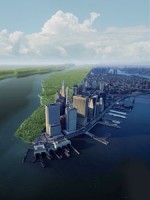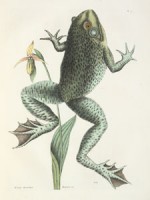Column Name
Title
If you want to get a sense of what Manhattan looked like centuries before Henry Hudson arrived in 1609, you should take in the exhibition “Mannahatta/Manhattan: A Natural History of New York City,” at the Museum of the City of New York. Eric Sanderson, a landscape ecologist who organized this exhibit, whetted our appetites last year with his inspiring talk for Juilliard’s Liberal Arts speaker series.
Mannahatta/Manhattan
(Photo by Left: © Markley Boyer, The Mannahatta Project, Wildlife Conservation Society; Right: © Yanan Arthus-Bertrand, CORBIS. Composite image by Markley Boyer.)Heath hen, a former denizen of the Harlem Plains
(Photo by Courtesy of the University of Wisconsin—Madison.)Body
This show is the fruit of Sanderson’s 10-year long Mannahatta Project, the goal of which was to uncover the original ecology of Manhattan. By means of digital technology and more traditional forms of media, the exhibit enables viewers to envision some of the city’s early natural landscape, which was characterized by an abundance of trees, flowers, birds, fish, and other wildlife. Before 1609, human beings and wildlife coexisted within this countryside for around 5,000 years. It may be hard to believe that our modern New York City was once made up primarily of forest and unpolluted lakes, rivers, and streams, but the Mannahatta Project has shown that with more than 55 different ecological communities, its biodiversity once rivaled that of national parks like Yellowstone and Yosemite.
By now, you may be wondering what this review is doing in a column called Focus on Art. Sanderson surely would not consider himself an artist or a curator in the ordinary sense of the word. According to the museum’s press release, he has “spearheaded,” rather than “curated,” this show, which is the first exhibition of its kind. But art and science have a long history of interconnectedness. In fact, the very word Mannahatta is associated with the art of poetry.
Walt Whitman wrote in his poem of that name:
I was asking for something specific and perfect for my city,
Whereupon lo! upsprang the aboriginal name.
Now I see what there is in a name, a lord, liquid, sane, unruly,
musical, self-sufficient
The link between art and science goes back many centuries. We have only to witness the work of Leonardo da Vinci and other Renaissance artists, as well as that of many early 19th century American painter-inventor-scientists, such as John James Audubon, Samuel F. B. Morse, Robert Fulton, and Charles Willson Peale.
With the resurgence of cross-disciplinary art in the 21st century, it has become increasingly difficult to label one exhibition “scientific” and another “artistic.” Today’s artists are often well informed, taking as their subject matter such items as complexity science, genomics, neuroscience, biotechnology, and synesthesia. Transgenic art, Internet art, and new media represent only a few of these manifestations.
At first, Sanderson’s project reminded me of Hudson River School painter Thomas Cole’s doctrinaire and moralistic “The Course of Empire” (1833-36), a series of five paintings (titled in order: The Savage State, The Arcadian or Pastoral State, The Consummation, Destruction, and Desolation) that shows the rise, development, greed, consumerism, and final fall of a fictional city/state. When the series was created, Americans feared, as they do today, that overdevelopment (“empire,” in this case) would ineluctably lead to destruction. There is even a specific parallel between “The Course of Empire” and “Mannahatta” in that both demonstrate the use of controlled fire—a method condoned by pastoralists, who were supportive of the Cole ideology early on, to maximize resources.
However, Sanderson suggests that the urban world did not really displace nature; it just reshaped it. Indeed, he uses the principles he finds from the study of the natural world—those of interaction and interdependence—and extends them to urban life, thereby shaping new connections in the viewer’s mind between the past and present.
The exhibit is unique in not attempting to demonstrate that human involvement and development have destroyed New York City’s ecology, but, rather, altered it. Some evolution has even been to the good. Sanderson began the Mannahatta Project in order to study the effect of humanity on the natural world. The goal of the project, he writes, “has never been to return Manhattan to its primeval state; rather, it is to discover something new about a place we all know so well.” For this reason, the exhibit seeks not only to show how the island of Manhattan looked when first explored by Henry Hudson, but also how it has changed—and why. Computer technology thus re-creates early Manhattan landscapes and superimposes contemporary cityscapes over them.
In his research, Sanderson made an important discovery: a detailed British military map dating from 1782 or 1783, which is displayed in the exhibition. This map is so accurate that it only deviates from present day ones by 40 meters, at most. It was essential in helping to reconstruct the island’s past: its hills, fields, streams, and fortifications. In addition to maps, graphic illustrations and antique-looking (but technologically advanced) camera obscuras take the viewer into ecological sub-areas; kiosk displays are devoted to individual neighborhoods. These are illuminated with charts and objects describing each area as a distinctive ecological niche. The interactive exhibits allow visitors to create “Muir Webs” (named for John Muir, the explorer-naturalist and founder of the Sierra Club) on computer screens. Using these, one can explore interconnections between animals, flora, and fauna, past and present: networks of biological interdependence. Also on view are hand-drawn, painstakingly detailed field notebooks and maps, made between 1812 and 1822 by John Randel Jr., showing the state of the island almost 200 years ago.
The presentation of the “Mannahatta” exhibition and two accompanying ones, “Dutch Seen: New York Rediscovered” and “Amsterdam/New Amsterdam: The Worlds of Henry Hudson,” is timed to coincide with the 400th anniversary of Henry Hudson’s entrance into New York Harbor. To underline the Dutch character of early New York City (then New Amsterdam), the former is a photo exhibition, a collaboration with a photography museum in Amsterdam, featuring specially-commissioned works by 12 artists—some internationally renowned and some young and emerging—exploring New York and New Yorkers through a Dutch perspective.
Now that Sanderson’s exhibition has seen the light of day at the Museum of the City of New York, aesthetic connections become apparent. The very beautiful, technologically enhanced, visually-stimulating, and thought-provoking show can certainly be considered art—in every respect. All good art has the effect of altering our perceptions. And we come away from “Mannahatta/Manhattan” with an entirely changed view of New York City, with special emphasis on our own neighborhoods.
“Mannahatta/Manhattan: A Natural History of New York City” continues through October 12. “Dutch Seen: New York Rediscovered” runs through September 13. Both are at the Museum of the City of New York, 1220 Fifth Avenue at 103rd Street.







